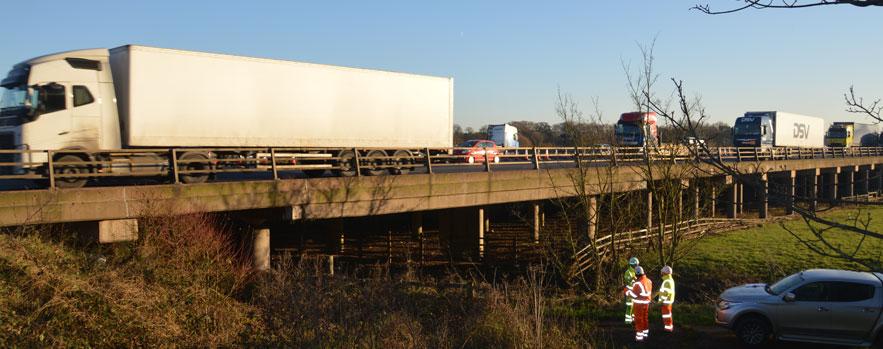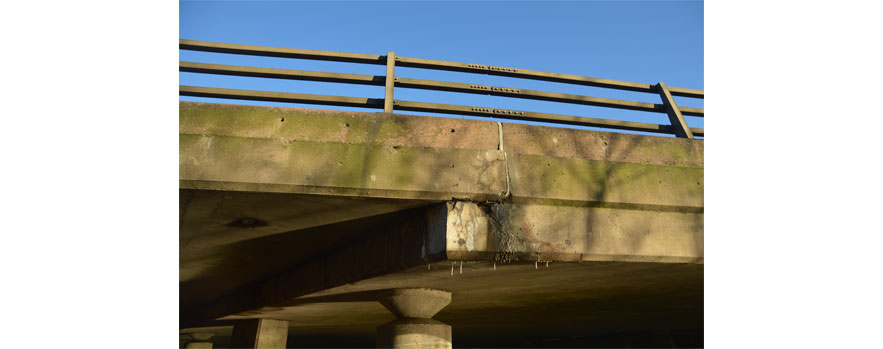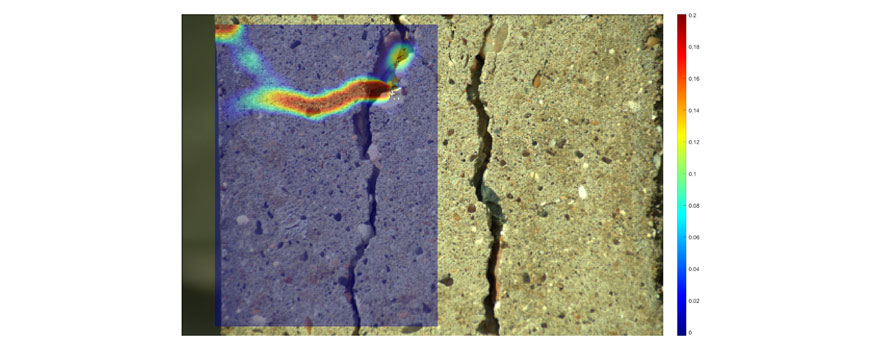
CSIC is working with industry partner Highways England and Kier Group to identify emerging sensing technologies and approaches for the structural assessment and deterioration detection of static highways assets. CSIC has been tasked with exploring the capabilities of acoustic emission (AE) sensing technology for the structural health monitoring of concrete bridges.
The structural condition of motorway bridges is commonly monitored through periodic site inspections, which result in significant cost and traffic disruptions that may be hazardous to road users. Even if these inspections are enhanced by conventional crack monitoring or surveying methods, the underlying deterioration in critical structural members is hard to assess.
A systems integration approach that brings together multi-sensing systems, ICT, computer vision technologies, cloud data management, statistics and big data analytics may offer a better understanding of underlying deterioration and overall structural performance, enabling effective structural alert systems for asset management.
High-end multi sensing systems
Acoustic emission sensors
AE sensing is a non-destructive testing (NDT) method. Unlike ultrasonic testing, AE is a passive technique that does not require external triggering, which makes it suitable for continuous remote monitoring of civil infrastructure. Well established in other areas of application, including pipeline networks, composite vessels and pressure equipment, the sensors receive and record energy release originating from leakage, cracking or corrosion, and can alert asset managers to the onset of damage.
While the application of AE technologies to monitor reinforced concrete deterioration in bridges is relatively novel, although it is an established method to detect wire breaking in suspension/cable stay and post-tensioned concrete bridges because wire breaking radiates a high energy acoustic wave resulting in a distinguishable signal.
Securing rich information
While effective, the monitoring of wire breaking in cables and tendons does not reflect the full potential of AE sensors for the study of deterioration in concrete bridges. There is also opportunity to secure rich information about (i) the early detection and 3D mapping of cracks in the body of concrete, and (ii) the mode and severity of the damage and the state of the structure by taking into account the entire information from the waveform of the AE signal. This is facilitated by recent advances in signal processing, clustering data analysis, AI and statistics.
Collaborating for shared benefits
CSIC is partnering with leading asset protection specialists to test, verify and further improve AE sensing systems and processing algorithms through detailed lab testing and alternative high- performance multi-sensing monitoring on site. This three-way collaborative research project is designed to accelerate industry uptake of the resulting innovative monitoring solutions.
The project will use AE sensors to monitor the half-joint – one of the most critical parts of a concrete bridge – which suffers from fatigue and moisture accumulation; a local failure may lead to partial or total bridge collapse making early detection and characterisation crucial. Many studies have been conducted to understand the behaviour of half-joints under monotonic loading, but knowledge of performance on cyclic or fatigue loading is limited.
Designing and developing a multi-sensing system
During two project phases – Develop and Demonstrate – CSIC will design and develop a multi-sensing system, comprising AE sensors, fibre optic strain sensors and environmental sensors in the lab. Detailed strain and environmental monitoring will help to interpret AE signals and verify the results of damage localisation and characterisation algorithms.
CSIC has new optical distributed sensing equipment for high-spatial resolution strain monitoring of concrete specimens. This information, together with strain field measurements from Digital Image Correlation (DIC) will be used to validate AE algorithms for early cracking detection and 3D mapping of damage.
Feature and waveform based AE analysis for source discrimination, source localisation and severity assessment will be tested, together with advanced signal processing algorithms (AI, advanced statistics and pattern recognition). The research project aims to understand the benefits and limitations of each approach and develop an optimum data processing methodology to improve data interpretation for half-joint bridges.
The ultimate goal of this research project is to develop real-time systems to detect the crack, and also identify the location, mode and severity of the damage to contribute significantly to the structural performance assessment of the structure.
Proof of concept monitoring with AE sensors
A damaged half-joint on a concrete bridge carrying the M6 motorway over the River Penk in Staffordshire, UK, will be instrumented with 24 AE sensors. A network of 80 fibre Bragg grating (FBG) sensors will be used to correlate the AE-monitored behaviour of concrete with deformation and validate the results from the damage severity and localisation AE algorithms developed during the experimental studies.
Sensors will be installed along the 40m-wide half-joint connection to detect weak regions and underlying deterioration such as reinforcement corrosion and internal cracking. This is critical information that is not accessible through site inspection. At selective locations, damage localisation will be attempted. The accuracy in detection of weak regions and damage will be assessed through correlation with FBG dynamic strain monitoring. Data from FBG temperature sensors and a weather station installed on the bridge will be used to decouple normal seasonal responses from structural deterioration.
Outcomes and benefits
The outcomes and benefits from this research project will: confirm the effectiveness of AE sensors for damage characterisation and localisation in concrete bridges through multi-sensing information and laboratory studies; test existing and develop new sophisticated algorithms for AE monitoring systems; optimise monitoring arrangements for concrete highway bridges; and provide continuous asset condition and degradation monitoring, enabling early warning systems and a ‘predict and prevent’ maintenance strategy.
Using computer vision to further understand bridge deterioration
An example of measuring crack opening in the vertical direction
Computer vision technologies are currently more versatile and efficient than ever before due to the development of cameras and computation power. Applying computer vision makes possible the deployment of novel solutions, ranging from advanced cameras measuring micron displacement of bridge defects to battery powered Internet-of-Things (IoT) systems tracking elements in a scene such as cars or trains. Digital image correlation is a full field displacement measurement technique with sub-pixel resolution that can map out the deformation. It is a very efficient tool to analyse local defects or crack formation with accurate measurement directly overlaid onto images of a concrete section.
It is also possible to deploy low-cost time-lapse cameras on more remote projects to track the evolution of different phenomena such as water leaks, traffic or changes in environment. The daily visual observation will enhance the data collected by other sensors, including fibre optics, providing better context and support to identify the main cause of damage. Such techniques can make use of commercial cameras that are more accessible and cheaper compared to other scientific instrumentation, which could support future deployments on other Highways England bridges.
Cloud data management and curation of real-time bridge monitoring data
CSIC aims to create a cloud-based data platform for asset management through the creation and integration of numerous digital twins modelling infrastructure networks. Data curation, management, and sharing strategies play a vital role in preparing to meet this long-term vision. Real-time monitoring data from different assets can be analysed and shared through well-defined and agreed protocols to make integrated and sustainable asset management practices possible.
Interoperability, systems-of-systems perspective and sustainable decision-making would be the core of this platform. Securely sharing the appropriate information with the different stakeholders enables overall digital twin integration, management and monitoring which would change the future of smart infrastructure management. The findings and rich information that will be collected throughout the Highways England Systems Integration for Resilient Infrastructure project and the proposed cloud-based data platform may contribute towards the National Digital Twin programme.
The Centre for Digital Built Britain’s National Digital Twin programme aims to steer the successful development and adoption of the information management framework for the built environment, and to create an ecosystem of connected digital twins – which opens the opportunity to release value for society, the economy, business and the environment. CSIC’s collaborative project with Highways England has potential to become one of many digital twins that would benefit stakeholders from effective information management through cloud- based data platforms which will enable interoperability and data sharing between different assets.
Acknowledgements
This project has been supported by the local community near the Penk River Bridge. CSIC is grateful to Jeff Lowe, Technical Director at Technobrake Ltd t/a Doctor Air Brake for providing electric power and space for the fibre optic analyser, and Richard Bower, land owner of Lower Drayton Farm, for providing space and facilitating the deployment.
CSIC team: Dr Haris Alexakis, Dr Jennifer Schooling, Dr Cedric Kechavarzi, Dr Nikolaos Tziavos, Dr Didem Gürdür Broo, Vladimir Vilde
Industry team: Ian Billington, Consultant Innovation Project Manager, Highways England, Mark Sheppard, Senior Project Manager, Kier Highways


